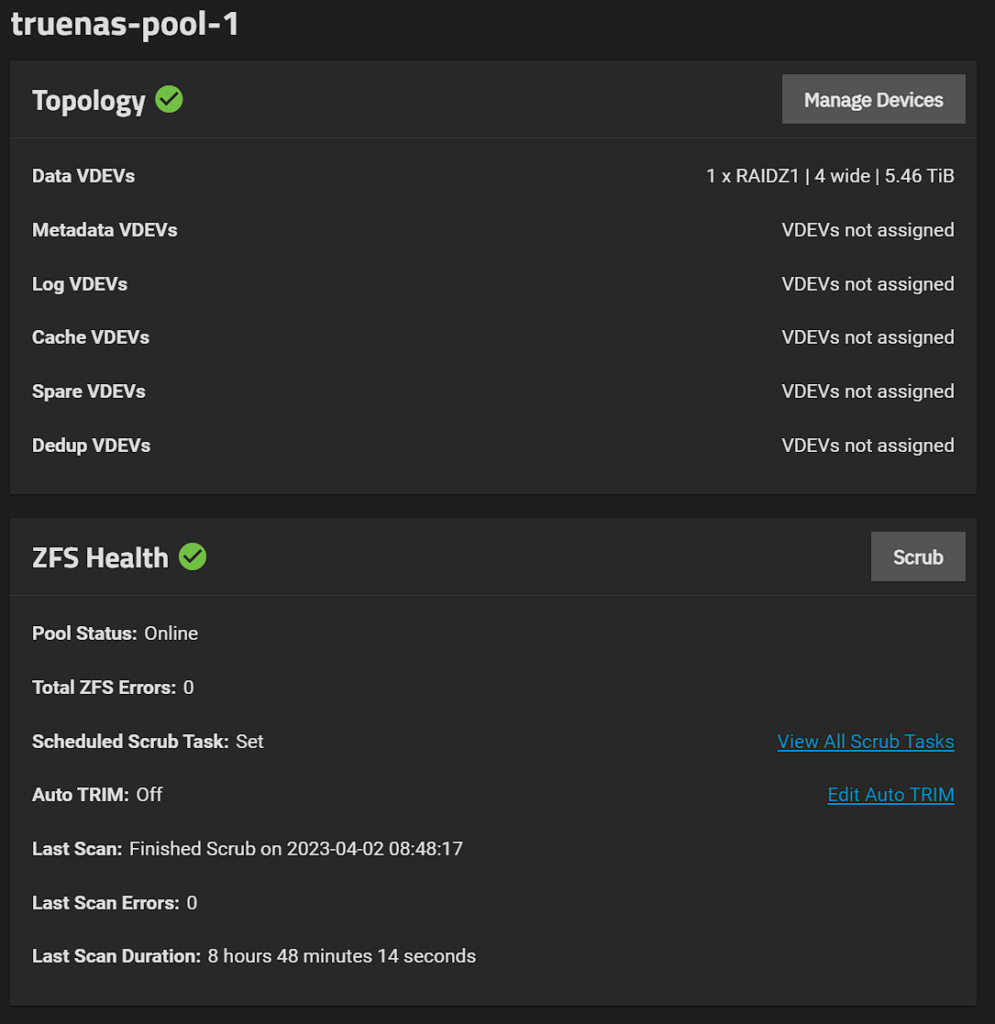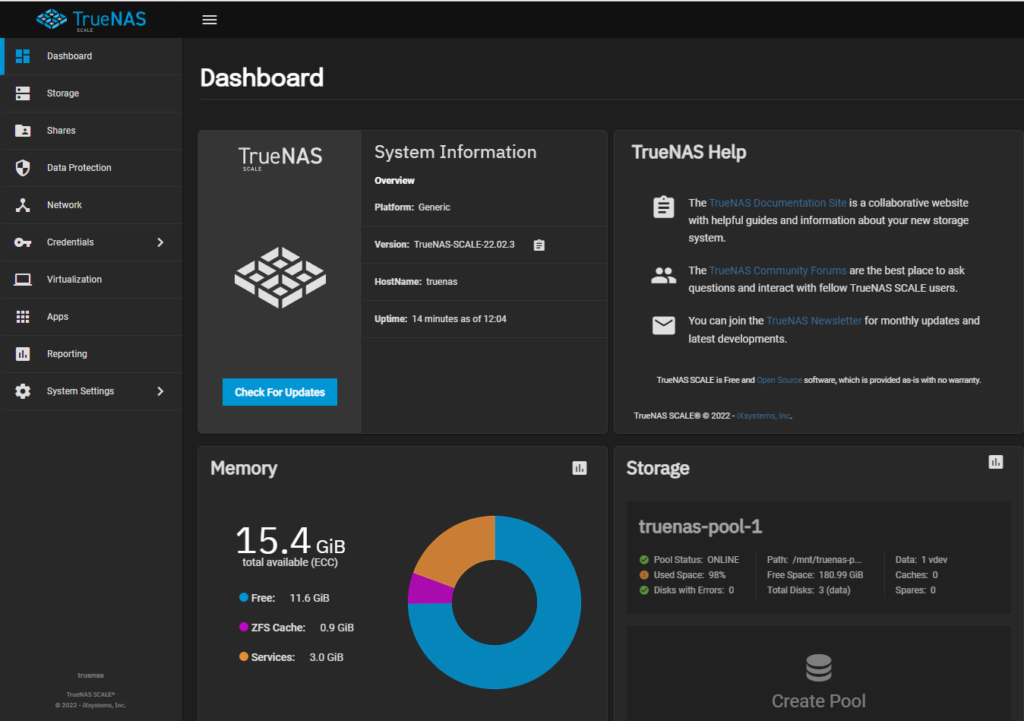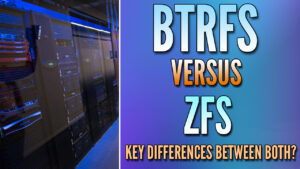In this article, we will look at a side-by-side comparison of ZFS vs. LVM. ZFS and LVM are both filesystems that can be used in various operating systems, so selecting the correct option (especially since you have to do it upfront) is extremely important!
ZFS and LVM are storage management solutions, each with unique benefits. ZFS combines a file system and volume manager, offering advanced features like data integrity checks, snapshots, and built-in RAID support. LVM is a separate volume manager, providing flexibility in storage allocation without ZFS’s advanced features.
ZFS vs. LVM: Side-by-Side Comparison
| Feature | ZFS | LVM (Logical Volume Manager) |
|---|---|---|
| Architecture | File system and volume manager combined | Volume manager separate from the file system |
| Data Integrity | Built-in data integrity checks (checksums) | Lacks built-in data integrity checks |
| Snapshots | Efficient snapshot support | Supports snapshots, but less efficient |
| Deduplication | Built-in data deduplication | Lacks built-in deduplication |
| Compression | Built-in data compression | Lacks built-in compression |
| RAID Support | Built-in RAID-Z support | Requires separate MD RAID for RAID configurations |
| Scalability | Pools can be easily expanded | Less flexible in expanding storage |
| Cache and SSD Support | Advanced caching with L2ARC and SLOG devices | Limited SSD caching support |
| Encryption | Native encryption support | Lacks native encryption; relies on external tools |
| Performance | Generally better performance due to caching | Good performance, but lacks advanced caching options |
| Complexity | Higher learning curve, more complex setup | Simpler setup and management |
What are ZFS and LVM?
Before we get into a detailed ZFS vs. LVM comparison, let’s take a look at exactly what ZFS and LVM are.
ZFS Filesystem Overview
ZFS stands for Zettabyte File System and is a highly scalable file system originally developed by Sun Microsystems (now owned by Oracle) for the Solaris operating system. It is widely used for its data integrity, protection features, and massive storage capacity.
ZFS includes built-in RAID, data compression, deduplication, and snapshots, making it a powerful choice for large-scale data storage and management.
It has since been ported to other platforms, including FreeBSD and Linux through the OpenZFS project. ZFS is widely used and is viewed as one of the best filesystems you can use due to features like:
- Copy-on-write (CoW) snapshots
- End-to-end data integrity checks
- Built-in RAID support
- Data deduplication and compression
One of the most popular platforms to run ZFS on is TrueNAS Core or TrueNAS Scale. However, it’s supported on tons of other operating systems as well, such as Proxmox, Unraid (support coming soon), and more.

LVM Overview
LVM (Logical Volume Manager) is not a file system itself but rather a storage management solution that works with file systems. It allows you to create, resize, and manage logical volumes, providing flexibility in storage allocation.
LVM operates at a layer above physical storage devices, which allows users to combine multiple disks or partitions into a single, larger virtual storage pool. This pool can then be divided into logical volumes, which can be formatted with a file system of your choice, such as Ext4 or XFS.
Here are some features of LVM:
- Storage flexibility: Manage logical volumes, pool multiple physical devices, and support various file systems.
- Enhanced functionality: Snapshots, striping, mirroring, and online resizing for improved storage management.
- Easy volume management: Easily handle physical devices in the storage pool without downtime.
Key Feature Comparison
A common question when setting up Proxmox is the correct storage type to use, with ZFS and LVM being common options. We’ll try and break down their key differences below!

Storage Management and Flexibility
One of the main differences when looking at ZFS vs. LVM is their approach to storage management. ZFS is both a filesystem and a volume manager, whereas LVM is only a volume manager that can work with various filesystems.
ZFS Storage Management
ZFS uses a unified storage pool called the ZFS Storage Pool (zpool) to manage all storage devices. This simplifies storage management by treating all devices as a single, large storage pool. You can then create filesystems, or datasets within the zpool, each with its own settings and properties.
LVM Storage Management
LVM, on the other hand, allows you to create and manage logical volumes on your storage devices. You can then apply any supported filesystem to those logical volumes.
This provides flexibility in choosing the best filesystem for your specific needs and allows you to mix and match different filesystems within a single LVM setup.
Data Integrity
When looking at ZFS vs. LVM from a data integrity perspective, ZFS is simply better. ZFS uses end-to-end checksums, which allows it to detect and repair data corruption automatically.
LVM (being a volume manager) does not have any built-in data integrity features, so it relies on the underlying filesystem to handle data integrity.
Snapshots
Both ZFS and LVM offer snapshot capabilities, but their implementations are different. ZFS uses a copy-on-write (CoW) approach that allows for efficient and almost instant snapshots. You can also create and manage clones from these snapshots.
LVM also supports snapshots, but its snapshot implementation can be slower and less space-efficient than ZFS. This is because LVM uses a copy-on-write (CoW) approach at the block level, which can lead to more storage space being used when changes are made to the original volume after a snapshot is taken.
Performance
Comparing performance in ZFS vs. LVM can be difficult because a lot of the time, it depends on the underlying filesystem used with LVM (as it’s simply a volume manager).
Generally, ZFS is known for having great performance. However, LVM can provide great performance as well, especially when used with specific (good-performing) filesystems like XFS or Ext4.
RAID Support
ZFS has built-in RAID support with various RAID-Z levels (RAID-Z, RAID-Z2, and RAID-Z3). This allows you to have redundancy and data protection directly in the ZFS storage pool.
| RAID-Z | RAID-Z2 | RAID-Z3 | |
|---|---|---|---|
| Redundancy | 1 disk | 2 disks | 3 disks |
| Data Loss Protection | 1 disk failure | 2 disk failures | 3 disk failures |
| Minimum Disks | 3 disks | 4 disks | 5 disks |
| Usable Storage Space | Total disks minus 1 | Total disks minus 2 | Total disks minus 3 |
LVM does not offer RAID support. However, you can use LVM in conjunction with Linux’s built-in software RAID (mdadm) to achieve a similar level of redundancy and data protection.
Which is Best for you? ZFS or LVM?
When deciding between ZFS vs. LVM, the decision really comes down to the situation you’re in and how you’d like to approach it. However, we’ll try and break down some key points that can help you decide below.
Operating System Compatibility
If you’re using Linux, LVM is the more native choice and generally has better support from Linux distributions. ZFS, while available on Linux through the OpenZFS project, may require extra steps to set up and maintain.
Data Integrity and Redundancy
If data integrity and built-in RAID support are important, ZFS may be the better choice. However, if you prefer a more flexible approach that allows you to mix and match filesystems and RAID configurations, LVM (with an appropriate filesystem) and mdadm for RAID may be an option.
Resource Usage
ZFS can be more resource-intensive, specifically when it comes to RAM usage. Since LVM is a more lightweight solution, it may be a better fit for systems with limited resources.

Usage and Management
LVM is tightly integrated with Linux and can be managed with familiar Linux tools and commands. ZFS has its own set of management tools and commands, which might have a steeper learning curve for those not comfortable with them.
Conclusion & Final Thoughts
This article looked at ZFS vs. LVM to understand their key differences. Ultimately, one isn’t better than the other and it’s important to understand how they both work so that you can implement the correct solution based on the requirements gathered.
Thanks for checking out the article on ZFS vs. LVM! If you have any questions on ZFS vs. LVM, please leave them in the comments!




